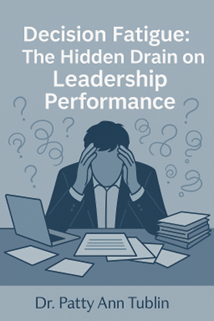
Let’s talk about something we rarely admit in business: the weight of making decisions day in and day out is slowly wearing you down—and it’s costing you your edge.
As a leader, you’re the go-to for answers. People line up (literally or figuratively) waiting for you to make the call. What marketing direction are we going in? Who should we hire? Should we invest in that new tech? And that’s just before lunch.
Here’s what most people don’t realize: decision fatigue is a real and dangerous phenomenon. And if you’re not careful, it will chip away at your ability to think clearly, lead effectively, and show up as your best self—at work and at home.
What Is Decision Fatigue—and Why Should You Care?
Decision fatigue happens when the quality of your decisions deteriorates after a long session of decision making. It’s the reason Steve Jobs wore the same black turtleneck every day. It’s why elite performers have morning routines that require zero thinking. They’re not lazy. They’re smart.
Because your mental energy is finite. Every single decision—big or small—draws from the same reservoir of focus and willpower.
And once that reservoir is depleted? You start defaulting to safe, easy, or emotionally-driven choices that often don’t serve your long-term goals.
How Decision Fatigue Shows Up in Business
- You delay hiring decisions and settle for “good enough” candidates.
- You micromanage because you don’t trust your depleted mind to hand off the reins.
- You say yes to meetings you shouldn’t be in.
- You overanalyze or underreact—either way, the outcome suffers.
- You zone out in critical conversations or misread your team’s energy.
Worse yet? You take this stress home. You snap at your spouse. You stare blankly at the fridge, unable to choose dinner. You feel exhausted—but haven’t physically done anything. That’s mental depletion in action.
3 Real-World Fixes to Reclaim Your Decision Power
This isn’t just theory. Here’s what I teach my high-performing clients to do immediately:
1. Automate the Trivial
Not everything needs a new decision. Create defaults—especially for routine tasks.
Think: same breakfast, same meeting structure, same format for reviewing team performance.
It’s not boring. It’s brilliant.
2. Schedule Thinking Time
Protect a daily block (even 15 minutes) where no one gets access to you. Use this time for proactive thinking, not just reacting to problems.
This is when your best strategic decisions get made—not in a back-to-back Zoom blur.
3. Delegate with Boundaries
If you’re the bottleneck, your team is stuck. Start small: push 1-2 decisions down to people you trust, with guardrails in place.
Let them know what they own and when to loop you in.
When done right, delegation builds capacity—yours and theirs.
Final Thought: It’s Not About Working Harder
You don’t need more hustle. You need more clarity. You’re not indecisive. You’re overwhelmed.
And the smartest leaders I work with? They stop trying to outmuscle their mental exhaustion. Instead, they create systems that allow them to stay sharp where it counts most. Start with one small change today. Your future self—and your business—will thank you.
Dr. Patty Ann
#Leadership #DecisionFatigue #EmotionalIntelligence #ExecutiveCoaching #SoftSkills #HumanBehavior
